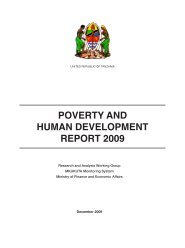Download PDF (4.08 MB) - ReliefWeb
Download PDF (4.08 MB) - ReliefWeb
Download PDF (4.08 MB) - ReliefWeb
You also want an ePaper? Increase the reach of your titles
YUMPU automatically turns print PDFs into web optimized ePapers that Google loves.
123<br />
a coordination platform should take place as early as possible in the programme cycle.<br />
Depending on the context and local capacities, a relevant line ministry can chair the platform,<br />
or a ministry can co-chair it with another organization—national or international. 70<br />
A wide range of partners should be invited to participate in the coordination platform,<br />
including government bodies that are responsible for early recovery, the U.N. agencies<br />
(e.g., ILO, UNIDO, FAO, UN-Habitat, UN Women, UNFPA, and UNEP), UN Mission representatives<br />
(in peacekeeping contexts), donors, international financial institutions, national and<br />
international NGOs, and private sector entities. Criteria for participation could include<br />
having a mandate and the authority to influence decision making regarding livelihoods<br />
and economic recovery; expertise and/or information concerning employment, income<br />
generation, reintegration, and livelihoods in general; operational capacities on the ground<br />
and knowledge of the local context; and access to the crisis-affected area. The selection<br />
of participants should ensure that the platform has expertise on conflict sensitivity and<br />
disaster risk reduction.<br />
References and suggested further reading:<br />
Coordination mechanisms<br />
• IASC Cluster Working Group on Early Recovery.<br />
Guidance Note on Early Recovery. Prepared<br />
in cooperation with the UNDG/ECHA Working<br />
Group on Transition, April 2008.<br />
• UNDP. Early Recovery White Paper. 2008.<br />
• UNDP. UNDP Policy on Early Recovery. UNDP<br />
Geneva, August, 2008.<br />
• United Nations. UN Operational Guidance Note<br />
on Post-Conflict Employment Creation, Income<br />
Generation and Reintegration. Draft: November<br />
4, 2009.<br />
Various structures are possible for the coordination platform. In crisis and post-crisis<br />
countries where the HC/RC launches the IASC “cluster approach,” UNDP Country Offices<br />
can facilitate the establishment of an early recovery cluster on livelihoods and economic<br />
recovery. Alternatively, when a more broadly defined early recovery cluster already exists,<br />
a subgroup within the cluster can focus on livelihoods and economic recovery. Countries<br />
where the UN Policy for Post-Conflict Employment Creation, Income Generation<br />
and Reintegration is rolled out (e.g., in Burundi, Côte d’Ivoire, Nepal and Sierra Leone in<br />
2010-2011) can have a cluster/subgroup on employment creation, income generation<br />
and reintegration—or the cluster/subgroup on livelihoods and economic recovery can<br />
specifically focus on employment, income, and reintegration issues. In countries without<br />
the cluster system, the coordination platform could take the form of a working group or<br />
task force for supporting government-led livelihoods and economic recovery processes.<br />
In some cases, like-minded members of the cluster may pursue joint assessments, joint<br />
programmes, and/or joint monitoring and evaluation.<br />
UNDP Country Offices can facilitate the formation of the resource mobilization task<br />
force within the coordination platform in order to engage with donors on the funding<br />
of livelihoods and economic recovery initiatives. These Country Offices can also support<br />
resource mobilization by seeking funding from UNDP’s TRAC 3 resources (category I, II<br />
and III) and/or the Thematic Trust Fund for Crisis Prevention and Recovery (CPR TTF). 71<br />
7.2 Strategic Communication<br />
The effective use of strategic communication is critical to the success of any effort to<br />
promote sustainable livelihoods and economic recovery. Experience and evidence have<br />
demonstrated that strategic communication enhances development effectiveness, country<br />
ownership, partnership building, and results management. Strategic communication<br />
is communication that is conceived, targeted, and executed to achieve a specific goal or<br />
result. For UNDP, the intended results of strategic communication often relate to resource<br />
mobilization, partnership building, policy and behaviour changes that are conducive<br />
to MDG achievement, public support for good governance, and knowledge transfer<br />
and retention. In a crisis or post-crisis situation, strategic communication helps to build<br />
momentum for recovery by rallying crisis-affected people, local leaders, and national<br />
70 This has been done successfully in Iraq and Sri<br />
Lanka. In Zimbabwe, an Economic Livelihoods,<br />
Infrastructure and Institutional Capacity Building<br />
Cluster was established. Key participating/cochairing<br />
ministries include the Ministry of Labour<br />
and Social Welfare and the Ministry of Small and<br />
Medium Enterprises; UNDP and IOM are the lead<br />
U.N. agencies.<br />
71 For more information, see section 7.3 below on<br />
resource mobilization.<br />
Livelihoods & Economic Recovery in Crisis Situations





